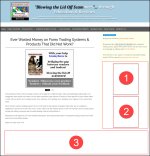- Home
- Trading Strategies
- 3 Vital Barometers for Forex Trading Newbies: RSI, Moving Average & Stochastic
3 Vital Barometers for Forex Trading Newbies: RSI, Moving Average & Stochastic
by John Arnold
(UK)
Forex trading analysis can be roughly broken down into 3 distinguishable varieties: Sentiment, Technical Analysis and Fundamental Analysis.
The usage of all 3 analysis varieties not only provides the optimal trading experience, but it also ensures that you get to enjoy the maximum amount of profit possible. While sentiment and fundamentals are easy to understand and implement, a sizeable number of traders make errors when it comes to technical analysis. Newbies end up using either an excess of barometers, or none at all.
If you are a new entrant to the world of Forex trading, this article will guide you through the three best barometers or indicators that you can use to improve your decision making process.
Stochastic
The Stochastic identifies the market conditions where too much buying or selling takes place and rates the situation on a scale of 0-100. A rating of 80 or more means overbought while 20 or less would mean oversold. It is a fine barometer which will help you anticipate where the price will be heading next.
If you are to make the most of this barometer, rehearse your actions for various readings. If the situation indicates overbought, then it is a sure way to know that you can go short as there is a high probability of the price going down.
RSI
The RSI, or Relative Strength Index, can be considered as being very similar to Stochastic. It is a scale which rates a currency pair when it is being overbought or oversold. The scale reads from 0-100 and 70 or more means the price is overbought while a rating of 30 or less would hint that the price is being sold too much.
When compared to Stochastic, the RSI is largely utilized to act as an extra confirmation and the difference in configuration between the two will allow you to analyze slightly different results. These differences can be taken into your overall consideration.
Moving Average
Moving averages are usually considered to be the simplest barometers and can be used to remove the noise surrounding price action and facilitate easier understanding of trends. You can fiddle around with the settings to dictate a line’s smoothness. The more smoother the line, the more stable and less reactive to price action it is.
Moving averages can be classified into two distinct varieties: simple (SMA) and exponential (EMA) moving averages. The latter lays extra focus on present price action and is regularly updated while the former tends to stay relatively smooth. The nature of this barometer provides you room to experiment by fiddling around with the settings for every currency pair. You will have the freedom to adapt to the market’s volatility as well as its price action.
Implementation in Your Daily Trading Workflow
Since you have been acquainted with the 3 vital barometers, it is important for you to understand how to go about integrating them into your everyday trading behavior or workflow. To begin with, it is advisable to dedicate an extra platform just for technical analysis.
MetaTrader is widely considered to be the industry standard for such a purpose. After downloading MetaTrader, all you have to do is to add the barometers to a chart and vary the settings to your liking. You can also access a few guides which will provide you the necessary help to understand everything.
All of the stuff mentioned above doesn’t mean that you have to focus on these barometers for an abnormal amount of time. They are extremely useful when it comes to analyzing the market, but they are just the means and not the end. In other words, they are not perfect and should mostly be utilized in the last stage of your decision making process before confirming a trade.





